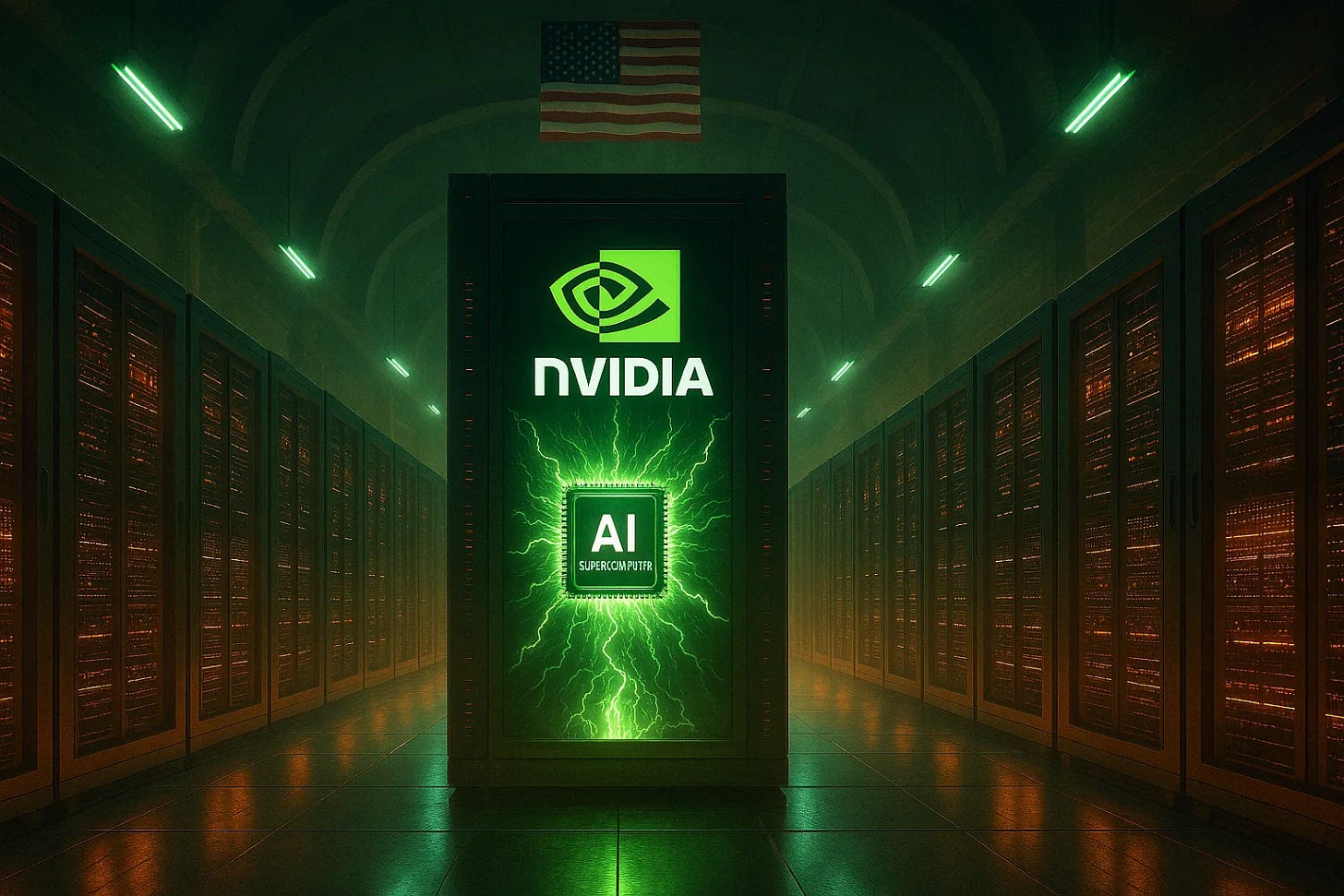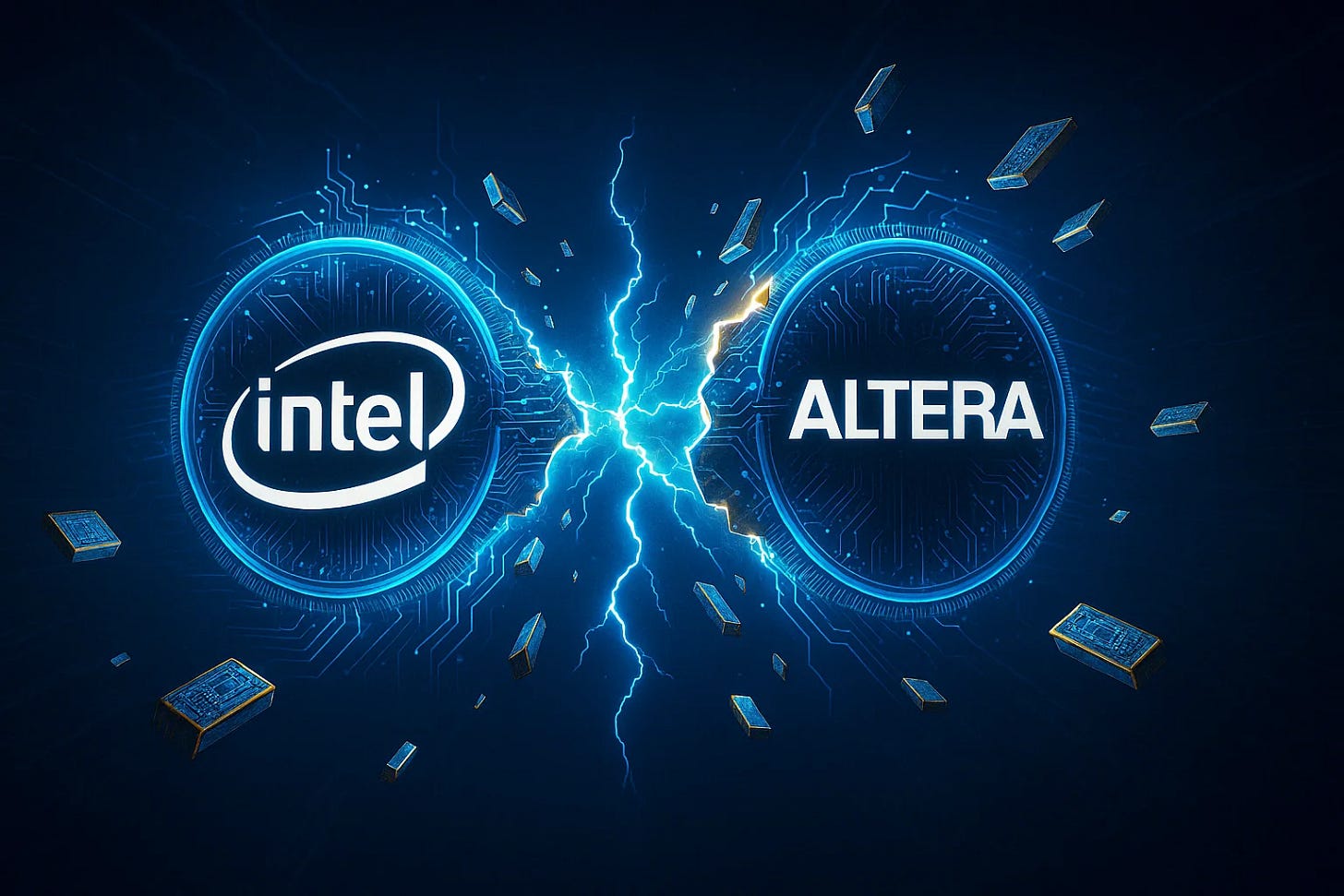📰 Semiconductor Face Tariff Tremors: U.S. Section 232 Probe Underway
Welcome, AI & Semiconductor Investors,
Semiconductors find themselves at the center of a major U.S. investigation targeting chip imports, with tariffs potentially shaking up global supply chains and raising tech prices—what could this mean for investors?
Meanwhile, NVIDIA makes a strategic pivot by moving AI supercomputer production stateside, and Intel undertakes a significant restructuring with its surprising Altera stake sale. — Let’s Chip In
What The Chip Happened?
📰 Semiconductor Face Tariff Tremors: U.S. Section 232 Probe Underway
🏭 NVIDIA’s Big Onshore Play: US-Made AI Supercomputers
💼Intel’s High-Stakes Altera Shake-Up: A Surprise Stake Sale
[Applied Digital’s Q3 2025 Earnings: Operational and Financial Highlights]
Read time: 7 minutes
Semiconductor Market
📰 Semiconductor Face Tariff Tremors: U.S. Section 232 Probe Underway
What The Chip: On April 14, 2025, the U.S. Department of Commerce announced a sweeping Section 232 investigation into semiconductor imports, aiming to determine whether they pose a national security threat. Chipmakers find themselves in the crosshairs as new tariffs—potentially starting at 25%—move closer to reality.
The Situation Explained:
🔎 Nationwide Scrutiny: Secretary of Commerce Howard Lutnick explained that the probe covers chips, semiconductor manufacturing equipment (SME), and even downstream products like laptops. “We must ensure America’s supply chain is robust and not at the mercy of foreign powers,” he said.
💰 Tariff Tensions: President Trump signaled that new chip tariffs could begin at around 25% and “increase substantially higher,” which might boost domestic manufacturing but also raise costs for U.S. tech firms.
🌎 Global Supply Web: Intel sources and sells chips worldwide, heavily relying on complex supply chains in East Asia. Import duties on semiconductors from Taiwan, Korea, and elsewhere could push up prices and disrupt production schedules.
📆 Comment Window: Investors have 21 days from the Federal Register notice to share their views, while Commerce has 270 days to finalize its findings. This timeline means tariff decisions could linger into next year.
🏭 Onshore Ambitions: Intel CEO Pat Gelsinger noted recently that “strengthening domestic manufacturing is good for national security,” but cautioned that “unilateral tariffs can also create unintended consequences.”
⚖️ Past Investigations: The administration recently used the same Section 232 process for copper and lumber, indicating a pattern of using these probes to justify higher tariffs on strategic imports.
📈 Market Impact: With the potential addition of smartphones, laptops, and other electronics under new chip-specific tariffs, demand forecasts may shift, impacting not only Intel’s margins but also broader consumer pricing.
Why AI/Semiconductor Investors Should Care: A forced realignment of the global chip supply chain could alter market dynamics for years. Tariffs might invigorate U.S.-based fabs, but they also raise the specter of higher manufacturing costs and retaliation from major Asian suppliers. For AI and semiconductor investors, understanding how these policies reshape production footprints, R&D investment, and end-user pricing will be crucial for navigating both risks and opportunities in the evolving tech landscape.
Moore Semiconductor Investing
📗 [NEW!!] Unlock Q4 Semiconductor Earnings --- 60% OFF (NEW EARNINGS)
What The Chip: Get a front-row seat to the financials shaping the semiconductor industry. This continuously updated e-book by Jose Najarro distills the latest Q4 quarterly insights—from wafer production trends to AI chip breakthroughs—into a single comprehensive resource.
The Situation Explained:
🔵 Dynamic Updates: Start with giants like TSMC and ASML, then expand to 30+ companies as their Q4 2024 earnings roll in. Earnings are restarting!!
🔵 Broad Coverage: From traditional chipmakers to cutting-edge AI semiconductor players, get the full picture as it emerges.
Why AI/Semiconductor Investors Should Care: This evolving earnings handbook gives you a strategic edge. Understanding quarterly earnings data is crucial for gauging industry health, discovering new growth leaders, and aligning your investment approach with emerging technological waves.
Disclaimer: For educational and informational purposes only. Not financial advice. Consult with a qualified professional before making any investment decisions. Updates are only for the Quarter of Earnings.
Nvidia (NASDAQ: NVDA)
🏭 NVIDIA’s Big Onshore Play: US-Made AI Supercomputers
What The Chip: NVIDIA just announced on April 14, 2025, that they’re bringing production of their next-generation Blackwell AI chips and supercomputers to the US for the first time. It’s a bold move that could help them sidestep potential tariffs, tap government incentives, and fortify their supply chain.
The Situation Explained:
⚙️ Domestic Production: NVIDIA is now working with TSMC’s Phoenix, Arizona fab to build Blackwell chips, signaling the start of onshore manufacturing.
🏭 Expanding US Footprint: Beyond Arizona, factories in Texas (with Foxconn in Houston and Wistron in Dallas) will assemble complete AI supercomputers. NVIDIA expects these efforts to create hundreds of thousands of jobs. Production is set to ramp up over the next 12-15 months.
💵 Half a Trillion in AI: The company aims to produce up to half a trillion dollars of AI infrastructure in the US over four years. NVIDIA is partnering with Amkor and SPIL for advanced packaging and testing, further strengthening domestic capabilities.
✂️ Tariff Shield: By shifting manufacturing onshore, NVIDIA can reduce risk from potential new tariffs. CEO Jensen Huang noted they “will manufacture as much onshore as we need to.”
⛓️ Supply Chain Security: Building chips and systems stateside lowers dependence on foreign fabs during geopolitical tensions. “The engines of the world’s AI infrastructure are being built in the United States,” Huang said.
Why AI/Semiconductor Investors Should Care: NVIDIA’s onshore push strengthens its long-term positioning, offering a hedge against trade and geopolitical risks. With AI increasingly central to industries worldwide, domestic manufacturing not only safeguards NVIDIA’s supply chain but also supports the US’s push to remain a leader in advanced semiconductor technology. This strategic shift could set the stage for sustained growth and innovation in the AI sector.
Intel (NASDAQ: INTC)
💼Intel’s High-Stakes Altera Shake-Up: A Surprise Stake Sale
What The Chip: On April 14, 2025, Intel announced it will sell a 51% stake in its Altera programmable chip division to investment firm Silver Lake. The $8.75 billion deal marks the first major move by new CEO Lip-Bu Tan to streamline Intel’s operations and shore up its finances.
The Situation Explained:
🔍 Valuation Dip: Intel originally acquired Altera for $16.7 billion in 2015, but today’s transaction values it at just $8.75 billion. The sale brings Intel roughly $4.46 billion in cash while retaining a 49% stake.
🤝 New Leadership: Raghib Hussain—previously Marvell’s president of Products and Technologies—takes over as Altera’s CEO on May 5, 2025, with plans to focus on FPGAs in AI, edge, and other fast-growth segments.
💼 Intel’s Balance Sheet Boost: CEO Lip-Bu Tan said, “Today’s announcement reflects our commitment to sharpening our focus, lowering our expense structure and strengthening our balance sheet.” This divestiture injects much-needed cash into Intel’s turnaround plan.
⚙️ Altera Goes Independent: Post-sale, Altera will become a standalone FPGA solutions giant, free to pivot quickly in telecom, defense, and robotics markets—while Intel remains a minority owner.
📉 Bearish Overhang: The nearly 50% valuation drop since 2015 highlights potential missteps in Intel’s earlier acquisition strategy and underscores the tough competition in FPGAs.
💡 Positive Market Reaction: Despite concerns about the valuation, Intel’s stock jumped around 4% initially and has risen about 3% overall since the announcement, suggesting Wall Street welcomes the refocus on core businesses.
Why AI/Semiconductor Investors Should Care: FPGAs are a key piece in the AI and data center puzzle, and Altera’s independence could accelerate innovation in these areas. For Intel, unlocking capital through targeted divestitures may strengthen its core CPU and contract manufacturing strategies—moves that could reshape the semiconductor landscape and open new opportunities for growth.
Youtube Channel - Jose Najarro Stocks
[NEW] Semiconductor Q4 Earnings Book — 60% OFF
X Account - @_Josenajarro
Disclaimer: This article is intended for educational and informational purposes only and should not be construed as investment advice. Always conduct your own research and consult with a qualified financial advisor before making any investment decisions.
The overview above provides key insights every investor should know, but subscribing to the premium tier unlocks deeper analysis to support your Semiconductor, AI, and Software journey. Behind the paywall, you’ll gain access to in-depth breakdowns of earnings reports, keynotes, and investor conferences across semiconductor, AI, and software companies. With multiple deep dives published weekly, it’s the ultimate resource for staying ahead in the market. Support the newsletter and elevate your investing expertise—subscribe today!
[Paid Subscribers] Applied Digital’s Q3 2025 Earnings: Operational and Financial Highlights
Date of Event: April 14, 2025
Executive Summary
*Reminder: We do not talk about valuations, just an analysis of the earnings/conferences
Applied Digital Corporation (Nasdaq: APLD), which designs, builds, and operates next-generation digital infrastructure for high-performance computing (HPC) applications, cloud services (Cloud Services), and data center hosting (Data Center Hosting), released its fiscal third quarter 2025 results on April 14, 2025. During the quarter ended February 28, 2025, the company reported increases in revenue, continued expansion of its HPC and Data Center Hosting businesses, and a decision by the Board of Directors to sell the company’s Cloud Services Business.
Key Financial Metrics and Developments:
Total Revenues: $52.9 million, representing a 22% increase from the year-ago period
Net Loss Attributable to Common Stockholders: $36.1 million, compared to $62.8 million in the comparable period last year
Adjusted Net Loss: $17.8 million
Adjusted EBITDA: $10.0 million
Cloud Services Business: Board approved a plan to sell this segment
Major Financings: A $375 million financing arrangement with Sumitomo Mitsui Banking Corporation (SMBC) and a potential up to $5 billion investment partnership with Macquarie Asset Management (MAM)
Notable Management Comments:
Wes Cummins, Chairman and CEO of Applied Digital, emphasized that the recent financings with globally recognized institutions—MAM and SMBC—reflect considerable confidence in the value and scalability of the company’s data center platform. Additionally, management cited a desire to focus on data center operations as it evaluates possibilities of a data center real estate investment trust (REIT) structure down the road.
“We are confident in the progress we are making and remain committed to delivering sustainable, long-term value for our investors,” said Wes Cummins.
Growth Opportunities
Applied Digital continues to pursue growth primarily in two areas: HPC Data Center Hosting and Data Center Hosting for cryptocurrency miners. Both segments share the common theme of large-scale power infrastructure, cost-efficiency, and specialized cooling or operational designs.
HPC and Next-Generation Data Center Expansion
The company broke ground on its first 100 MW (megawatt) HPC facility in Ellendale, North Dakota, in the prior fiscal year. This 369,000-plus-square-foot building is designed for high-performance computing applications and features advanced liquid-cooling capabilities. Construction of this Ellendale campus remains on schedule, with expectations that the first building will be ready for service in the second half of calendar year 2025.Beyond the initial 100 MW, Applied Digital is planning two additional buildings at the Ellendale campus, each offering 150 MW of critical IT load, for a total of 400 MW. With Macquarie’s potential investment of up to $5 billion, the company believes it can expand further to meet hyperscaler demand for HPC capacity in a market driven by artificial intelligence (AI) and machine learning workloads.







